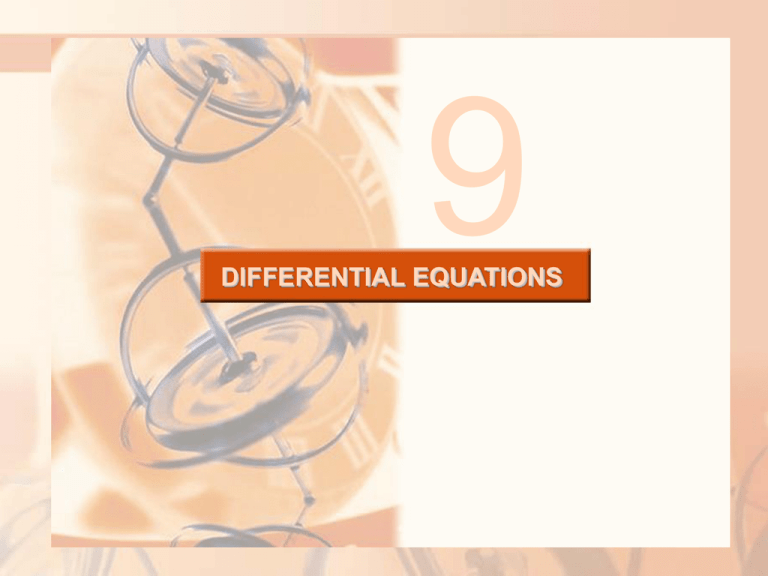predator-prey systems - Department of Mathematics | Illinois State
advertisement

9 DIFFERENTIAL EQUATIONS DIFFERENTIAL EQUATIONS We have looked at a variety of models for the growth of a single species that lives alone in an environment. DIFFERENTIAL EQUATIONS 9.6 Predator-Prey Systems In this section, we will learn about: Models that take into account the interaction of two species in the same habitat. PREDATOR-PREY SYSTEMS We will see that these models take the form of a pair of linked differential equations. PREDATOR-PREY SYSTEMS We first consider the following situation. One species, the prey, has an ample food supply. The second, the predator, feeds on the prey. PREDATOR-PREY SYSTEMS Examples of prey and predators include: Rabbits and wolves in an isolated forest Food fish and sharks Aphids and ladybugs Bacteria and amoebas PREDATOR-PREY SYSTEMS Our model will have two dependent variables, and both are functions of time. We let R(t) be the number of prey (R for rabbits) and W(t) be the number of predators (W for wolves) at time t. ABSENCE OF PREDATORS In the absence of predators, the ample food supply would support exponential growth of the prey, that is, dR kR dt where k is a positive constant. ABSENCE OF PREY In the absence of prey, we assume that the predator population would decline at a rate proportional to itself, that is, dW rW dt where r is a positive constant. PREDATOR-PREY SYSTEMS With both species present, we assume that: The principal cause of death among the prey is being eaten by a predator. The birth and survival rates of the predators depend on their available food supply—namely, the prey. PREDATOR-PREY SYSTEMS We also assume that the two species encounter each other at a rate that is proportional to both populations and is, therefore, proportional to the product RW. The more there are of either population, the more encounters there are likely to be. PREDATOR-PREY SYSTEMS Equation 1 A system of two differential equations that incorporates these assumptions is dR kR aRW dt dW rW bRW dt where k, r, a, and b are positive constants. PREDATOR-PREY SYSTEMS Notice that: The term –aRW decreases the natural growth rate of the prey. The term bRW increases the natural growth rate of the predators. LOTKA-VOLTERRA EQUATIONS The equations in (1) are known as the predator-prey equations, or the Lotka-Volterra equations. They were proposed as a model to explain the variations in the shark and food-fish populations in the Adriatic Sea by the Italian mathematician Vito Volterra (1860–1940). PREDATOR-PREY SYSTEMS A solution of this system of equations is a pair of functions R(t) and W(t) that describe the populations of prey and predator as functions of time. As the system is coupled (R and W occur in both equations), we can’t solve one equation and then the other. We have to solve them simultaneously. PREDATOR-PREY SYSTEMS Unfortunately, it is usually impossible to find explicit formulas for R and W as functions of t. However, we can use graphical methods to analyze the equations. PREDATOR-PREY SYSTEMS Example 1 Suppose that populations of rabbits and wolves are described by the Lotka-Volterra equations with: k = 0.08, a = 0.001, r = 0.02, b = 0.00002 The time t is measured in months. PREDATOR-PREY SYSTEMS Example 1 a. Find the constant solutions (called the equilibrium solutions) and interpret the answer. b. Use the system of differential equations to find an expression for dW/dR. PREDATOR-PREY SYSTEMS Example 1 c. Draw a direction field for the resulting differential equation in the RW-plane. Then, use that direction field to sketch some solution curves. PREDATOR-PREY SYSTEMS Example 1 d. Suppose that, at some point in time, there are 1000 rabbits and 40 wolves. Draw the corresponding solution curve and use it to describe the changes in both population levels. e. Use (d) to make sketches of R and W as functions of t. PREDATOR-PREY SYSTEMS Example 1 a With the given values of k, a, r, and b, the Lotka-Volterra equations become: dR 0.08 R 0.001RW dt dW 0.02W 0.00002 RW dt PREDATOR-PREY SYSTEMS Example 1 a Both R and W will be constant if both derivatives are 0. That is, R’ = R(0.08 – 0.001W) = 0 W’ = W(– 0.02 + 0.00002R) = 0 PREDATOR-PREY SYSTEMS Example 1 a One solution is given by: R = 0 and W = 0 This makes sense. If there are no rabbits or wolves, the populations are certainly not going to increase. PREDATOR-PREY SYSTEMS Example 1 a The other constant solution is: 0.08 W 80 0.001 0.02 R 1000 0.00002 So, the equilibrium populations consist of 80 wolves and 1000 rabbits. PREDATOR-PREY SYSTEMS Example 1 a This means that 1000 rabbits are just enough to support a constant wolf population of 80. The wolves aren’t too many—which would result in fewer rabbits. They aren’t too few—which would result in more rabbits. PREDATOR-PREY SYSTEMS Example 1 b We use the Chain Rule to eliminate t : Hence, dW dW dR dt dR dt dW dW 0.02W 0.00002 RW dt dR dR 0.08R 0.001RW dt PREDATOR-PREY SYSTEMS Example 1 c If we think of W as a function of R, we have the differential equation dW 0.02W 0.00002 RW dR 0.08R 0.001RW PREDATOR-PREY SYSTEMS Example 1 c We draw the direction field for the differential equation. PREDATOR-PREY SYSTEMS Example 1 c Then, we use the field to sketch several solution curves. PREDATOR-PREY SYSTEMS Example 1 c If we move along a solution curve, we observe how the relationship between R and W changes as time passes. PREDATOR-PREY SYSTEMS Example 1 c Notice that the curves appear to be closed in the sense that, if we travel along a curve, we always return to the same point. EQUILIBRIUM POINT Example 1 c Notice also that the point (1000, 80) is inside all the solution curves. It is called an equilibrium point. It corresponds to the equilibrium solution R = 1000, W = 80. PHASE PLANE Example 1 c When we represent solutions of a system of differential equations as here, we refer to the RW-plane as the phase plane. PHASE TRAJECTORIES Example 1 c Then, we call the solution curves phase trajectories. So, a phase trajectory is a path traced out by solutions (R, W) as time goes by. PHASE PORTRAIT Example 1 c A phase portrait, as shown, consists of: Equilibrium points Typical phase trajectories PREDATOR-PREY SYSTEMS Example 1 d Starting with 1000 rabbits and 40 wolves corresponds to drawing the solution curve through the point P0(1000, 40). The figure shows the phase trajectory with the direction field removed. PREDATOR-PREY SYSTEMS Example 1 d Starting at the point P0 at time t = 0 and letting t increase, do we move clockwise or counterclockwise around the phase trajectory? PREDATOR-PREY SYSTEMS Example 1 d If we put R = 1000 and W = 40 in the first differential equation, we get: dR 0.08(1000) 0.001(1000)(40) dt 80 40 40 PREDATOR-PREY SYSTEMS Example 1 d Since dR/dt > 0, we conclude that R is increasing at P0. So, we move counterclockwise around the phase trajectory. PREDATOR-PREY SYSTEMS Example 1 d We see that, at P0, there aren’t enough wolves to maintain a balance between the populations. So, the rabbit population increases. PREDATOR-PREY SYSTEMS Example 1 d That results in more wolves. Eventually, there are so many wolves that the rabbits have a hard time avoiding them. PREDATOR-PREY SYSTEMS Example 1 d Hence, the number of rabbits begins to decline. This is at P1, where we estimate that R reaches its maximum population of about 2800. PREDATOR-PREY SYSTEMS Example 1 d This means that, at some later time, the wolf population starts to fall. This is at P2, where R = 1000 and W ≈ 140. PREDATOR-PREY SYSTEMS Example 1 d However, this benefits the rabbits. So, their population later starts to increase. This is at P3, where W = 80 and R ≈ 210. PREDATOR-PREY SYSTEMS Example 1 d Consequently, the wolf population eventually starts to increase as well. This happens when the populations return to their initial values (R = 1000, W = 40), and the entire cycle begins again. PREDATOR-PREY SYSTEMS Example 1 e From the description in (d) of how the rabbit and wolf populations rise and fall, we can sketch the graphs of R(t) and W(t). PREDATOR-PREY SYSTEMS Example 1 e Suppose the points P1, P2, and P3 are reached at times t1, t2, and t3 . PREDATOR-PREY SYSTEMS Then, we can sketch graphs of R and W, as shown. Example 1 e PREDATOR-PREY SYSTEMS Example 1 e To make the graphs easier to compare, we draw them on the same axes, but with different scales for R and W. PREDATOR-PREY SYSTEMS Example 1 e Notice that the rabbits reach their maximum populations about a quarter of a cycle before the wolves. REAL-WORLD PREDICTIONS An important part of the modeling process, as discussed in Section 1.2, is to interpret our mathematical conclusions as real-world predictions and test them against real data. REAL-WORLD PREDICTIONS For instance, the Hudson’s Bay Company, which started trading in animal furs in Canada in 1670, has kept records that date back to the 1840s. REAL-WORLD PREDICTIONS The graphs show the number of pelts of the snowshoe hare and its predator, the Canada lynx, traded over a 90-year period. REAL-WORLD PREDICTIONS You can see that the coupled oscillations in the hare and lynx populations predicted by the Lotka-Volterra model do actually occur. REAL-WORLD PREDICTIONS The period of these cycles is roughly 10 years. SOPHISTICATED MODELS Though the relatively simple Lotka-Volterra model has had some success in explaining and predicting coupled populations, more sophisticated models have also been proposed. MODIFYING LOTKA-VOLTERRA EQUATIONS One way to possibly modify the Lotka-Volterra equations is to assume that, in the absence of predators, the prey grow according to a logistic model with carrying capacity K. MODIFYING LOTKA-VOLTERRA EQUATIONS Then, the Lotka-Volterra equations are replaced by the system of differential equations dR R kR 1 aRW dt K dW rW bRW dt This model is investigated in Exercises 9 and 10. SOPHISTICATED MODELS Models have also been proposed to describe and predict population levels of two species that compete for the same resources or cooperate for mutual benefit. Such models are explored in Exercise 2.







